Designing a shared bedroom for two boys can feel like solving a complex puzzle. You’re juggling different personalities, ages, interests, and the eternal struggle for personal space in a room that needs to function for both sleep and play.
Whether your boys are close in age or several years apart, creating a harmonious space that reflects both their individual identities while promoting brotherly bonding is entirely achievable.
The key lies in smart space planning, creative storage solutions, and design choices that can grow with them.
Two Boys Bedroom Ideas
From bunk bed configurations that maximize floor space to clever room dividers that give each child their own zone, the right approach can transform even the smallest bedroom into a functional haven.
These 14 ideas blend practicality with style, ensuring your boys have a space they’ll love spending time in while giving you the peace of mind that comes with an organized, efficient room layout.
1. Classic Bunk Bed Adventure Zone
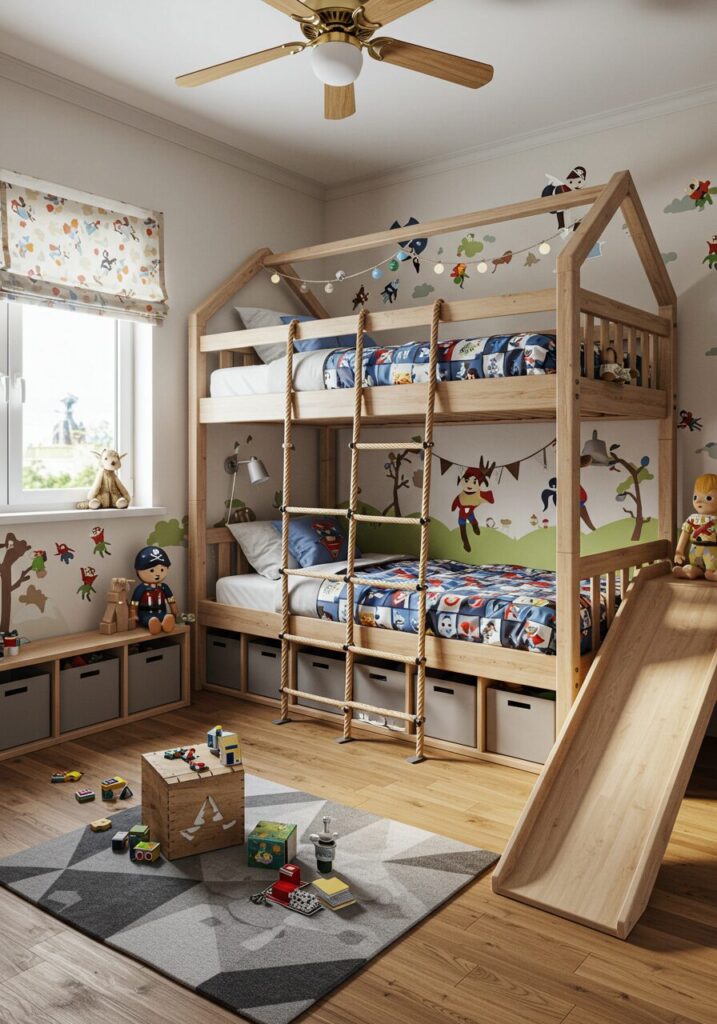
Transform the traditional bunk bed into an adventure headquarters by incorporating themed elements around the sleeping area. Consider adding a rope ladder, small climbing holds, or even a slide for the lower bunk to create an exciting play element.
Designate specific zones around each bunk for personal belongings and create built-in storage cubbies within the bed frame structure. This approach maximizes vertical space while giving each boy his own distinct sleeping sanctuary.
The beauty of this setup lies in its ability to make bedtime feel like an adventure rather than a chore. Add themed bedding that reflects each child’s interests, whether it’s pirates, astronauts, or superheroes.
Having designed countless shared bedrooms, I’ve found that themed bunk beds become the room’s focal point and often eliminate arguments about who sleeps where when each level has its own distinct personality.
2. Twin Bed Symmetrical Layout
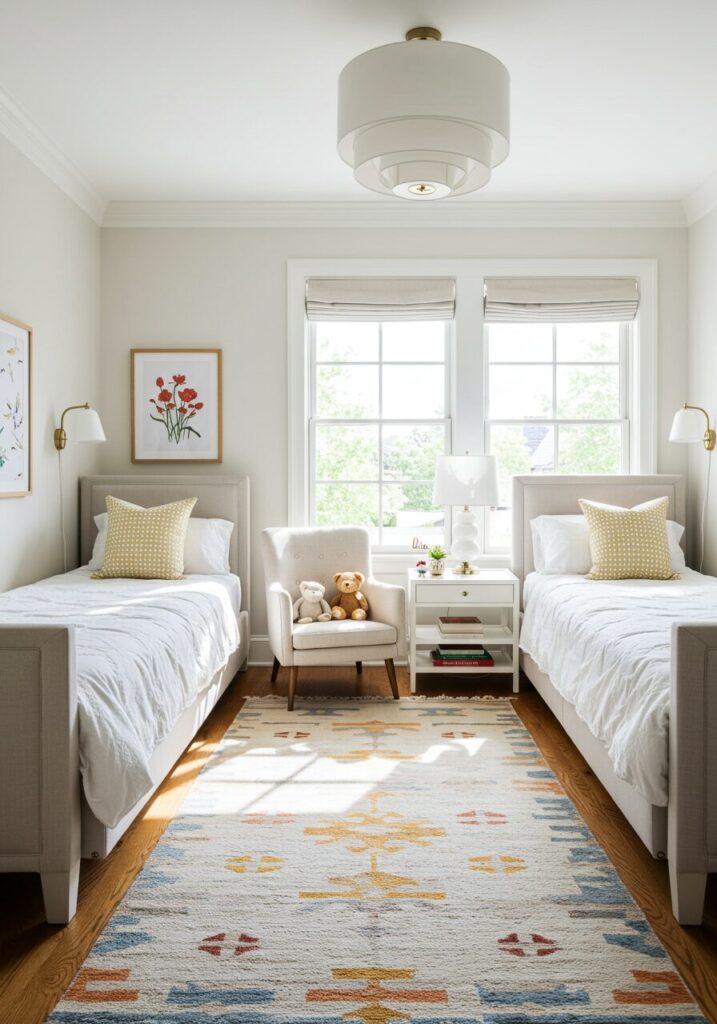
Create a balanced, harmonious feel by placing identical twin beds on opposite walls with matching nightstands and lamps. This layout promotes equality and reduces sibling rivalry over who has the “better” side of the room.
Use a large area rug in the center to define the shared play space, and consider adding a comfortable reading chair or bean bags between the beds. This creates a natural gathering spot for both boys.
Personalize each side with different colored accent pillows, throw blankets, or small decorative elements while maintaining the overall symmetrical design. This gives each child ownership of their space without disrupting the room’s visual balance.
3. Loft Bed with Study Station
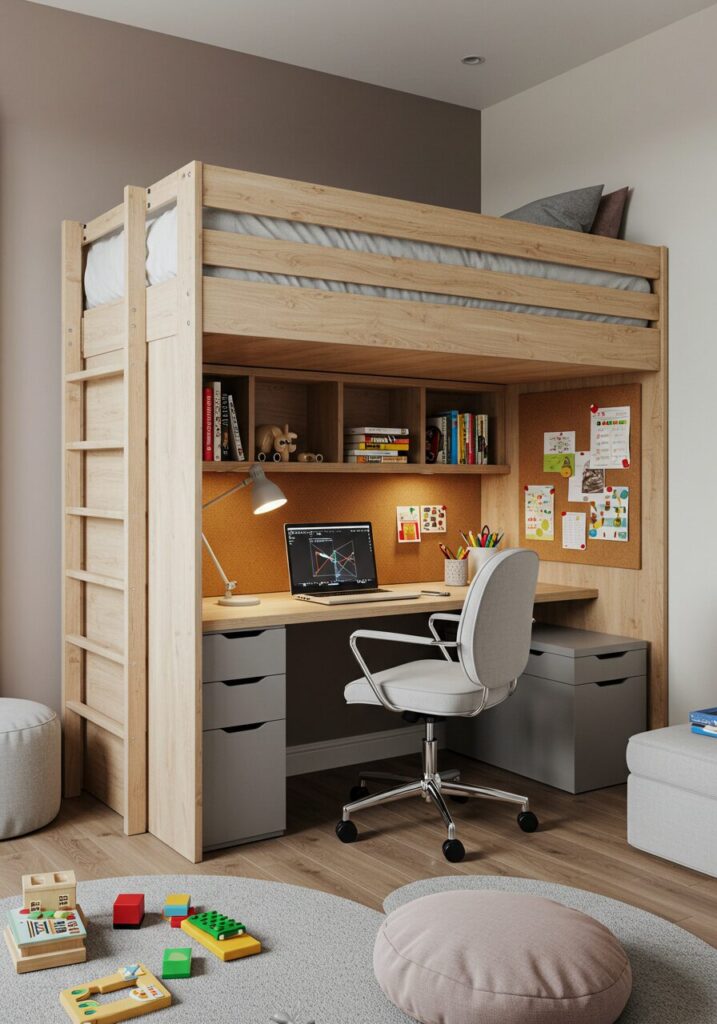
Elevate one or both beds to create valuable floor space underneath for desks, study areas, or play zones. This vertical approach is perfect for older boys who need dedicated homework spaces.
Install proper lighting under each loft area and ensure the desk setup includes adequate storage for school supplies and books. Consider adding cork boards or magnetic boards for displaying artwork and important reminders.
The space underneath can also serve dual purposes – study area during the day and play space in the evening. Choose furniture pieces that can easily be moved or reconfigured as needs change.
Pro Tip: Always ensure loft beds meet safety standards and are appropriate for your child’s age – typically recommended for children 6 years and older.
4. Shared Walk-In Closet Conversion
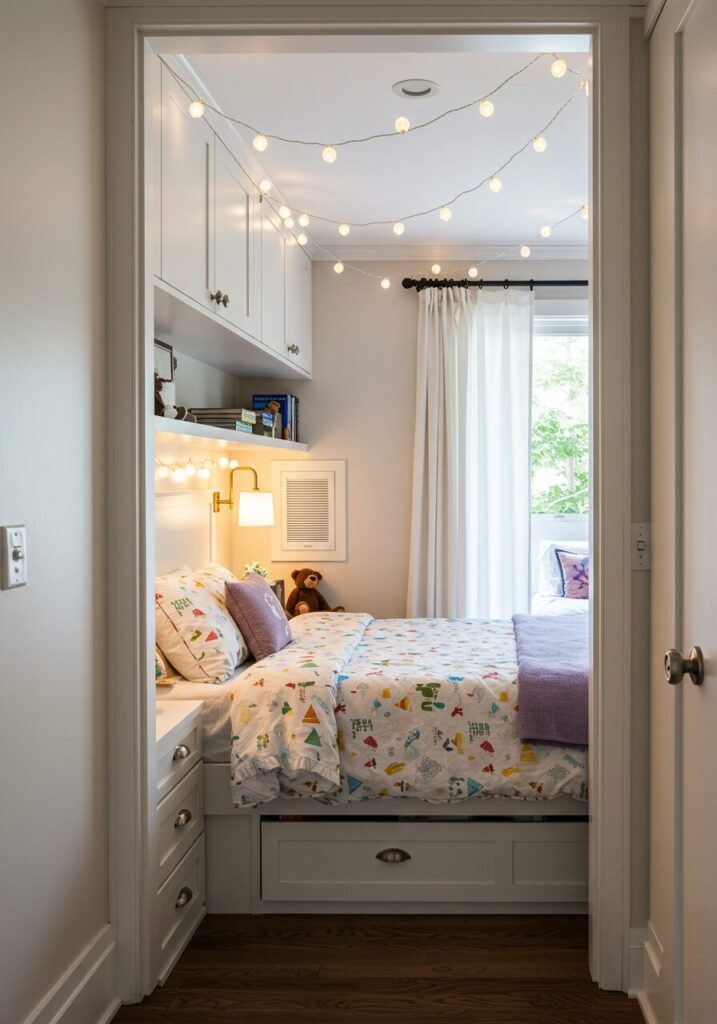
Convert a walk-in closet into a cozy sleeping nook for one child while the main room serves the other. This creative solution works particularly well when you have a large closet space available.
Install proper ventilation, lighting, and safety features in the closet-turned-bedroom. Add fun elements like fairy lights or glow-in-the-dark stars to make the space feel magical rather than cramped.
Ensure the “cave” sleeper has easy access to the main room and doesn’t feel isolated. This setup often becomes the coveted sleeping spot that boys actually argue over who gets to use.
5. Industrial Pipe Bed Frames
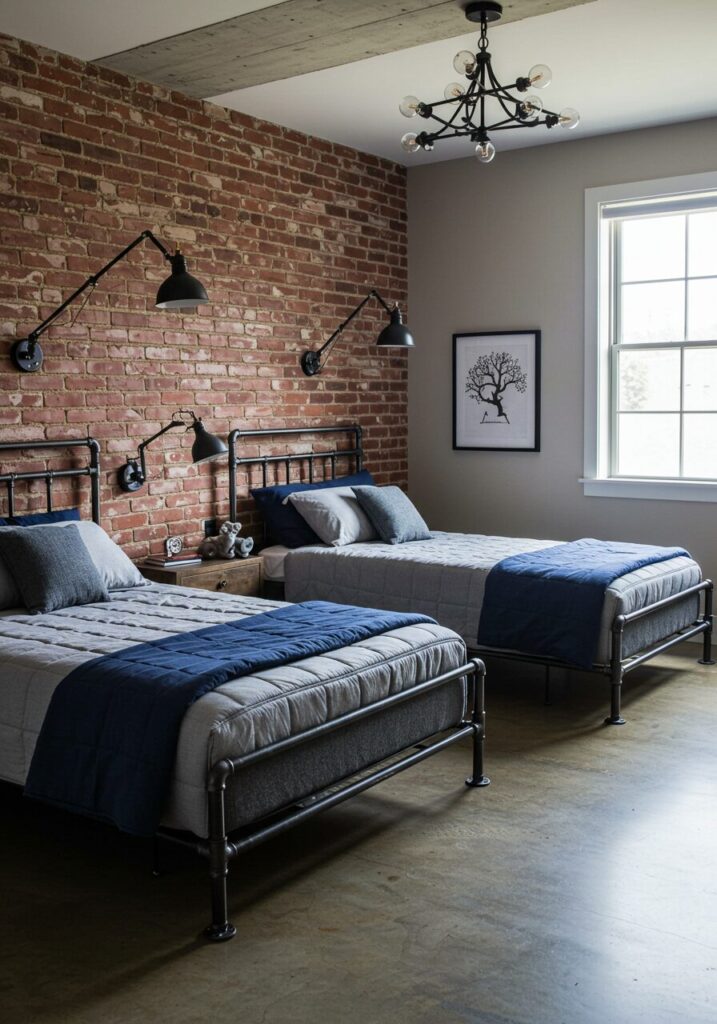
Create unique, sturdy bed frames using industrial pipes and fittings for a modern, masculine look that appeals to many boys. These DIY-style beds can be customized in height and configuration to fit your specific space.
The industrial aesthetic works well with exposed brick walls, concrete floors, or modern minimalist decor. Add comfortable mattresses and soft bedding to balance the harder industrial elements.
This approach allows for easy modification as the boys grow – the frames can be adjusted, reconfigured, or even separated into individual beds if needed. The sturdy construction also handles active boys who might be rough on furniture.
Note: Ensure all pipe connections are properly secured and regularly check for stability, especially with active children who might climb or jump on beds.
6. Themed Room Divider Solutions
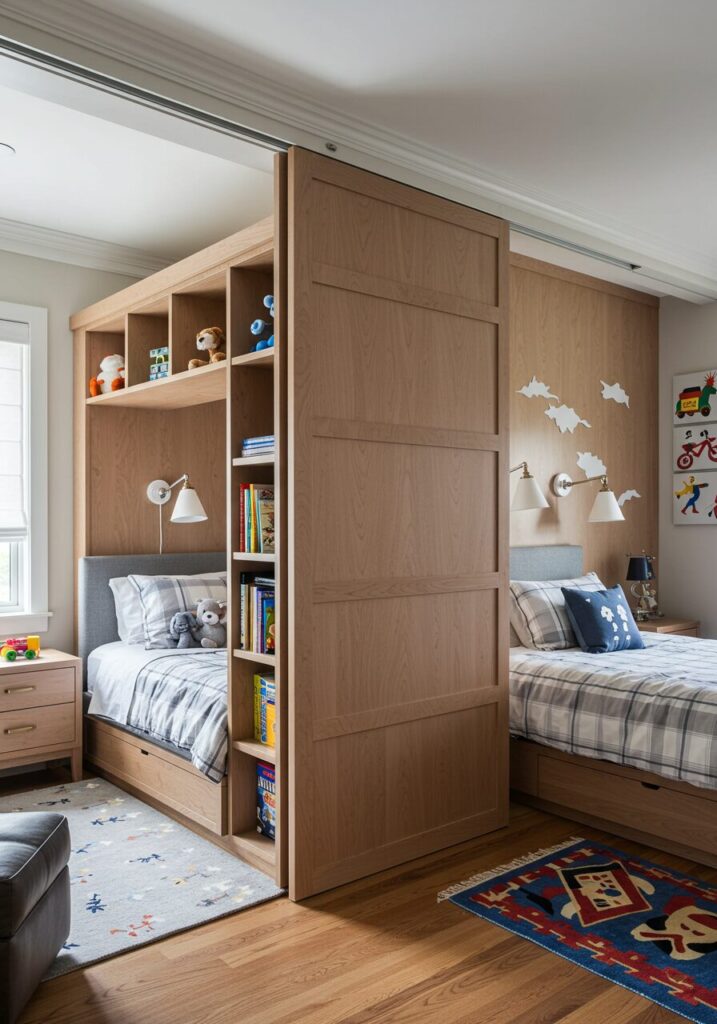
Install a creative room divider that gives each boy privacy while maintaining the open feel of the shared space. Options include sliding barn doors, curtain panels, or even a bookshelf that serves dual purposes.
Choose dividers that reflect the boys’ interests – perhaps a bookshelf filled with their favorite stories, or panels that can display artwork and achievements. The divider should enhance rather than interrupt the room’s flow.
Temporary or adjustable dividers work best as they can be opened for shared activities and closed when privacy is needed. This flexibility teaches boys to respect each other’s space while maintaining their close bond.
7. Under-Bed Storage Solutions
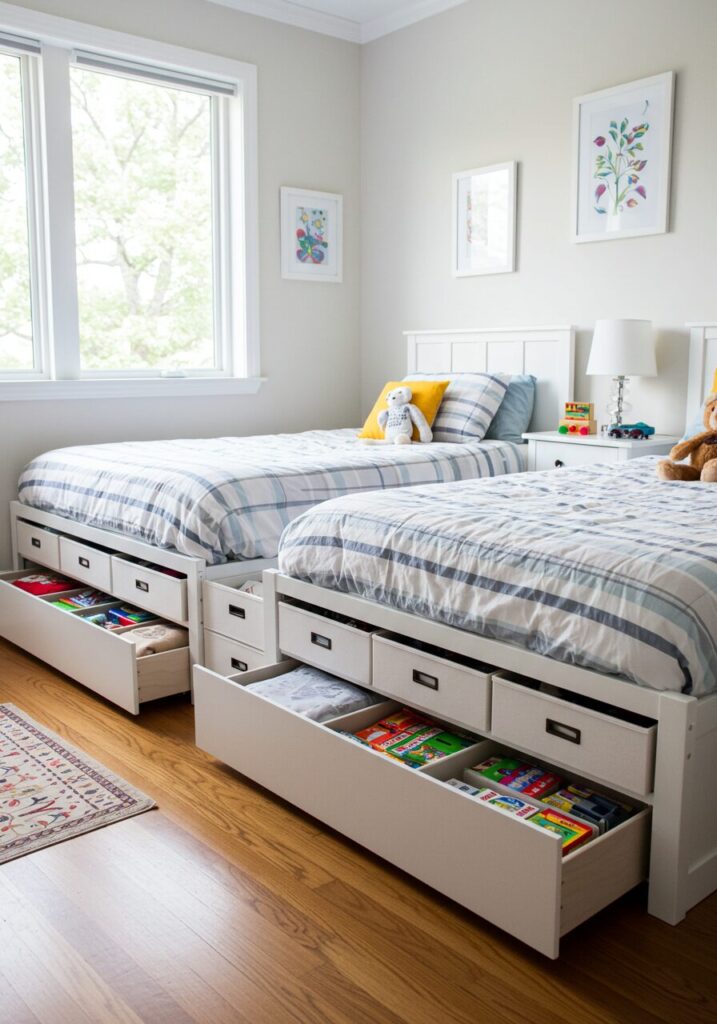
Maximize storage by utilizing the space under beds with rolling drawers, storage boxes, or built-in compartments. This keeps toys, clothes, and personal items organized while maintaining clean sight lines in the room.
Choose storage solutions that are easy for children to access independently. Label containers with pictures and words to help younger boys maintain the organization system.
Under-bed storage is particularly valuable in shared rooms where closet space is limited. Assign specific containers to each child to maintain ownership and reduce conflicts over belongings.
Tip: Invest in quality rolling mechanisms for under-bed storage – cheap wheels will break quickly and make the system frustrating to use.
8. Color-Coded Personal Zones

Assign each boy a signature color that carries throughout their personal items, bedding, and designated areas. This creates clear ownership while maintaining a cohesive overall design in the shared space.
Use the assigned colors in subtle ways – perhaps one boy gets blue hangers, storage bins, and desk accessories while the other gets green. This system extends to everything from toothbrushes to backpack hooks.
The color coding eliminates arguments about whose belongings are whose while teaching organizational skills. It also makes cleanup easier when everything has a designated, color-coded home.
9. Murphy Bed Space-Saver

Install a Murphy bed or fold-down bed to create maximum play space during the day while providing comfortable sleeping arrangements at night. This solution works particularly well for boys who spend more time playing than in their room.
Ensure the Murphy bed mechanism is safe and easy enough for children to operate with adult supervision. The wall space above can be utilized for storage or display when the bed is folded up.
This approach transforms the bedroom into a true multi-purpose space – playroom by day, bedroom by night. It’s especially valuable in smaller homes where every square foot counts.
10. Built-In Reading Nook
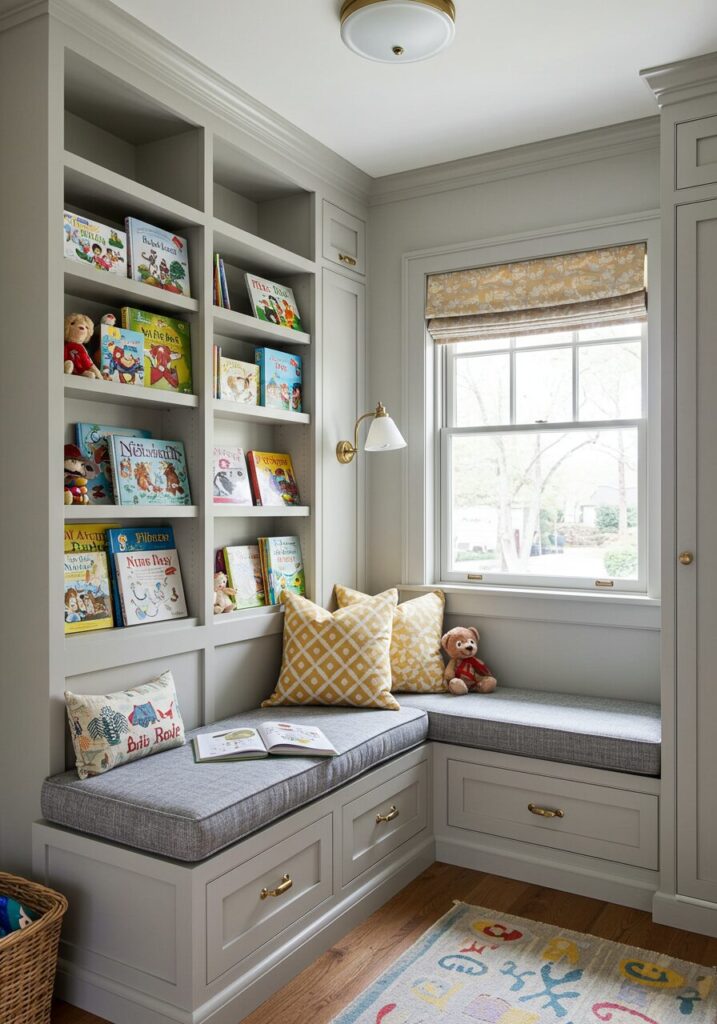
Create a cozy reading corner with built-in bench seating, cushions, and surrounding bookshelves. This designated quiet space encourages literacy while providing a retreat area within the shared room.
Include adequate lighting for reading and comfortable cushions that invite lingering. The nook can serve as neutral territory where both boys can enjoy quiet activities together or separately.
Consider adding small storage compartments within the bench for books, games, or quiet toys. This creates a self-contained activity zone that doesn’t interfere with sleeping areas.
Pro Tip: Position the reading nook away from beds to avoid disruption during different bedtimes, especially if your boys have different sleep schedules.
11. Shared Desk Command Center

Design a long, shared desk area with individual sections for each boy’s homework, crafts, and personal projects. Include proper task lighting and ergonomic seating for both children.
Organize the desk with individual storage solutions – perhaps drawers or cubbies assigned to each child. Include shared supplies in central locations while maintaining personal workspace boundaries.
The command center should accommodate different ages and activities, with adjustable elements that can grow with the boys. Consider including a shared calendar or bulletin board for family activities and important dates.
12. Adventure Tent Sleep Space
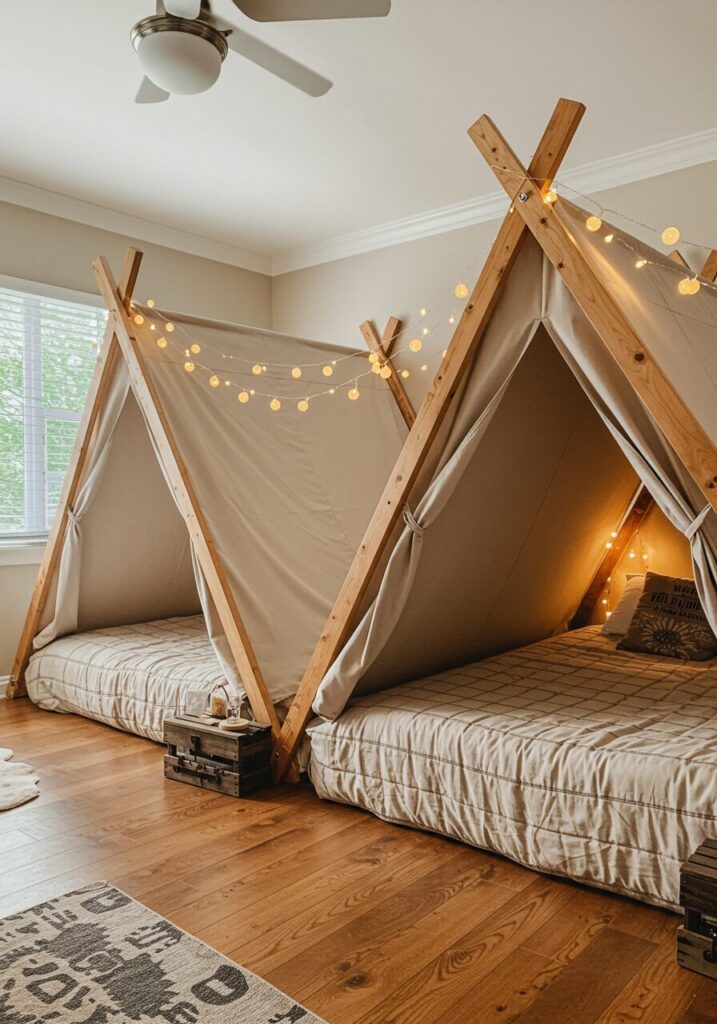
Create permanent or semi-permanent tent structures within the room for a camping adventure feel. These can be simple fabric drapes over bed frames or more elaborate wooden frame constructions.
The tent concept appeals to boys’ sense of adventure while providing a cozy, private sleeping environment. Include battery-powered lanterns or string lights for safe, fun illumination.
This setup can be easily modified or removed as boys outgrow the theme, making it a flexible option that doesn’t require permanent room modifications. It also encourages imaginative play and storytelling.
13. Sports Equipment Organization Wall
Install a comprehensive wall organization system for sports equipment, from hooks for helmets and bags to compartments for balls and gear. This keeps active boys’ equipment accessible but organized.
Create designated spaces for each type of equipment and label everything clearly. Include areas for seasonal rotation – winter gear storage and summer equipment display areas.
The organization wall serves as both functional storage and room decoration, celebrating the boys’ athletic interests while teaching responsibility for equipment care and maintenance.
Note: Regularly rotate seasonal equipment to prevent the wall from becoming overcrowded and ensure only current-season items are easily accessible.
14. Gaming and Tech Station

Designate a specific area for gaming consoles, computers, or other technology with proper cable management and comfortable seating for both boys. Include rules and time-sharing agreements for peaceful coexistence.
Ensure the tech area doesn’t dominate the room but rather integrates well with sleeping and study spaces. Consider using a media cabinet that can be closed when not in use.
Include charging stations for personal devices and headphone storage to minimize conflicts over shared equipment. The setup should encourage both solo and cooperative gaming experiences.
Conclusion
Creating the perfect shared bedroom for two boys requires balancing individual needs with shared functionality, but the results are worth the effort. These 14 ideas demonstrate that limited space doesn’t mean limited possibilities – with creative thinking and smart design choices, any shared bedroom can become a harmonious haven that both boys will love.
The key to success lies in involving your boys in the design process, understanding their individual personalities, and choosing solutions that can adapt as they grow.
Whether you opt for the adventure of themed bunk beds, the practicality of Murphy beds, or the organization of color-coded zones, remember that the best bedroom design is one that reflects your family’s unique needs and lifestyle.
Most importantly, don’t feel pressured to implement every idea at once. Start with one or two concepts that address your biggest challenges, then gradually add elements as budget and time allow.
The goal is creating a space where your boys can sleep, play, study, and grow together while maintaining their individual identities and fostering the special bond that comes from sharing childhood memories in a thoughtfully designed space.
